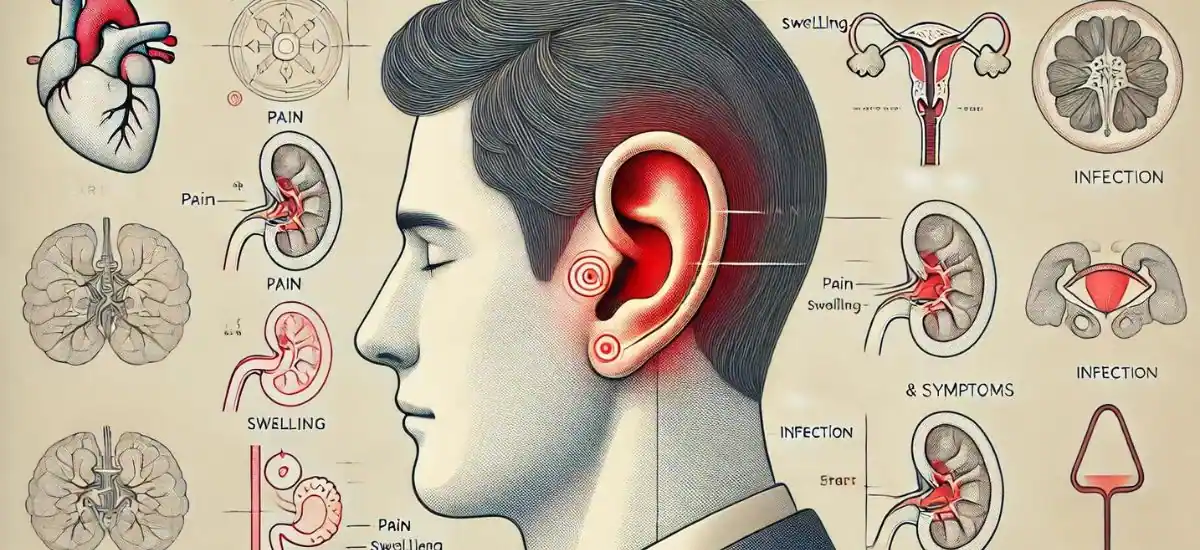Ear infections manifest through various symptoms that can affect individuals differently depending on the type and severity. Common signs include pain in the ear, which may be sharp or throbbing, hearing loss, fever, especially in children, and drainage of fluid from the ear, which could indicate a rupture in the eardrum.
Additional symptoms such as difficulty sleeping, a sense of fullness or pressure in the ear, and dizziness or balance issues are also indicative of an ear infection. It’s crucial to monitor these symptoms closely, as they can escalate quickly, especially in younger patients. Yes, these symptoms are clear indicators that an ear infection may be present and should be evaluated by a healthcare provider to prevent further complications and ensure effective treatment.
Understanding Ear Infections
Types of Ear Infections
Ear infections can be categorized into three main types, each affecting different parts of the ear:
- Outer Ear Infections (Otitis Externa): Often known as “swimmer’s ear,” this condition is typically caused by water that remains in the ear after swimming, creating a moist environment that aids bacterial growth.
- Middle Ear Infections (Otitis Media): These are the most common, especially in children, and occur when fluid builds up behind the eardrum and gets infected.
- Inner Ear Infections (Labyrinthitis): Although less common, they can cause severe symptoms such as vertigo and hearing loss.
Common Causes of Ear Infections
Ear infections can be triggered by a variety of factors, but the most prevalent causes include:
- Bacterial and Viral Infections: These are the primary culprits, especially for middle ear infections.
- Environmental Triggers: Allergens, excessive moisture, and foreign objects can all lead to infections, particularly in the outer ear.
- Anatomical Factors: Individuals with narrow or eustachian tubes that are more horizontally positioned (common in young children) are at higher risk for middle ear infections.
Signs and Symptoms of an Ear Infection

Pain in the Ear (Otalgia)
Pain is the most noticeable and common symptom of an ear infection. It can vary greatly:
- Outer Ear Pain: Typically sharp and intense, exacerbated by pulling on the outer ear.
- Middle Ear Pain: Often a deep, throbbing pain due to pressure buildup from fluid accumulation.
- Inner Ear Pain: Can be dull or piercing, frequently accompanied by other serious symptoms like dizziness.
Hearing Loss
Temporary hearing loss is often reported in patients with middle and inner ear infections. This occurs due to the inflammation and fluid buildup which hampers the normal transmission of sound.
Drainage of Fluid
Any drainage from the ear warrants attention. Clear fluid might suggest a tear in the eardrum, while pus or cloudy fluid could indicate an infection.
Fever
Fever often accompanies ear infections, particularly in children. It’s a natural immune response indicating that the body is fighting off an infection. The presence of fever can help differentiate between a viral or bacterial cause and can sometimes escalate quickly in younger patients.
Difficulty Sleeping
Ear pain can significantly disrupt sleep due to the increased pressure when lying down. Many individuals, especially children, may experience restless nights and discomfort that intensifies upon reclining.
Fullness or Pressure
A sensation of fullness or pressure in the ear often accompanies an ear infection. This feeling is caused by fluid buildup behind the eardrum in middle ear infections, or inflammation in the ear canal for outer ear infections.
Dizziness or Balance Issues
Inner ear infections can impact balance and orientation, leading to dizziness or vertigo. These symptoms occur because the inner ear is responsible for regulating balance and spatial orientation.
Specific Signs in Different Age Groups
Infants and Toddlers
- Irritability: Young children may be fussier than usual due to pain.
- Excessive Crying: Pain from an ear infection can cause continuous crying.
- Tugging at the Ears: Children might pull or tug at their ears due to discomfort.
Children
- Reduced Responsiveness to Sounds: Children might not respond to sounds as quickly due to temporary hearing loss.
- Loss of Appetite: Pain and discomfort may reduce their usual appetite.
Adults
- Persistent Pain: Adults may experience ongoing pain that doesn’t seem to improve with standard home care.
- Hearing Difficulties: Adults might also report diminished hearing capacity or a plugged ear sensation.
When to Seek Medical Help

Prompt medical evaluation is recommended if:
- Symptoms Persist or Worsen: If symptoms do not improve with home care or suddenly get worse.
- Severe Symptoms: Intense pain, significant hearing loss, or high fever.
- Recurrent Infections: Frequent infections can indicate a more serious underlying condition.
Preventive Measures and Early Detection
Preventing ear infections primarily involves:
- Keeping the Ears Dry and Clean: Avoid letting water sit in the ears, especially after swimming or bathing.
- Avoiding Exposure to Illness: Minimize contact with individuals who have respiratory infections, particularly in settings like schools or daycare centers.
- Appropriate Ear Care: Avoid inserting objects into the ear, such as cotton swabs, which can damage the ear canal and eardrum.
Emphasizing the importance of early detection can prevent complications such as hearing loss or more severe infections.
Frequently Asked Questions
Q1. What does ear infection pain feel like?
Ans: Ear infection pain can range from a dull throb to a sharp, intense pain, depending on the infection type and severity.
Q2. Can an ear infection go away on its own?
Ans: Some mild ear infections can resolve without medical treatment, but monitoring symptoms closely is essential to avoid complications.
Q3. When should I worry about an ear infection in my child?
Ans: Consult a doctor if your child has severe pain, fever, fluid drainage, or symptoms that do not improve within 24-48 hours.
Conclusion
Recognizing the signs of an ear infection and understanding when to seek professional help are crucial for effective management and quick recovery. Always consult healthcare professionals if you suspect an ear infection, especially if symptoms are severe or do not improve with initial care.


